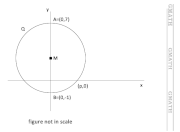The center of circle Q is on the y-axis, and the circle passes through points (0, 7) and (0, -1). Circle Q intersects the positive x-axis at (p, 0). What is the value of p?
$$A.\ \frac{7}{3}$$
$$B.\ 4$$
$$C.\ 5$$
$$D.\ \sqrt{7}$$
$$E.\ \sqrt{11}$$
OA D
Source: Magoosh
The center of circle Q is on the y-axis, and the circle pass
This topic has expert replies
-
BTGmoderatorDC
- Moderator
- Posts: 7187
- Joined: Thu Sep 07, 2017 4:43 pm
- Followed by:23 members
Timer
00:00
Your Answer
A
B
C
D
E
Global Stats
GMAT/MBA Expert
- Jeff@TargetTestPrep
- GMAT Instructor
- Posts: 1462
- Joined: Thu Apr 09, 2015 9:34 am
- Location: New York, NY
- Thanked: 39 times
- Followed by:22 members
We see that (0, 7) and (0, -1) are the endpoints of a diameter of circle Q. Since the center of a circle is the midpoint of a diameter and the diameter is 8, the radius is 4, and, hence, the center of circle Q must be at (0, 3).BTGmoderatorDC wrote:The center of circle Q is on the y-axis, and the circle passes through points (0, 7) and (0, -1). Circle Q intersects the positive x-axis at (p, 0). What is the value of p?
$$A.\ \frac{7}{3}$$
$$B.\ 4$$
$$C.\ 5$$
$$D.\ \sqrt{7}$$
$$E.\ \sqrt{11}$$
Since circle Q intersects the positive x-axis at (p, 0), we know that the distance between the center of circle Q (0,3) and the point (p,0) is 4, the radius of circle Q. Thus, can create the equation using the distance formula:
√[(p - 0)^2 + (0 - 3)^2] = 4
√[p^2 + 9] = 4
p^2 + 9 = 16
p^2 = 7
p = ±√7
Since p is on the positive x-axis, p = √7.
Answer: D
Jeffrey Miller
Head of GMAT Instruction
[email protected]

See why Target Test Prep is rated 5 out of 5 stars on BEAT the GMAT. Read our reviews
- fskilnik@GMATH
- GMAT Instructor
- Posts: 1449
- Joined: Sat Oct 09, 2010 2:16 pm
- Thanked: 59 times
- Followed by:33 members
\[? = p\]BTGmoderatorDC wrote:The center of circle Q is on the y-axis, and the circle passes through points (0, 7) and (0, -1). Circle Q intersects the positive x-axis at (p, 0). What is the value of p?
$$A.\ \frac{7}{3} \,\,\,\,\,\,\,\, B.\ 4 \,\,\,\,\,\,\,\, C.\ 5 \,\,\,\,\,\,\,\, D.\ \sqrt{7} \,\,\,\,\,\,\,\, E.\ \sqrt{11}$$
\[\left. \begin{gathered}
A = \left( {0,7} \right) \hfill \\
B = \left( {0, - 1} \right)\,\, \hfill \\
\end{gathered} \right\}\,\,\,\,AB\,\,\, = \,\,{\text{diameter}}\]
\[ \odot \,\,\left\{ \begin{gathered}
\,\,{\text{centre = M = }}\left( {\frac{{0 + 0}}{2}\,\,;\,\,\,\frac{{7 + \left( { - 1} \right)}}{2}} \right) = \left( {0,3} \right) \hfill \\
\,\,{\text{radius}} = dist\left( {A,M} \right) = dist\left( {B,M} \right) = 4 \hfill \\
\end{gathered} \right.\]
\[ \odot \,\,:\,\,\,\,{\left( {x - 0} \right)^2} + {\left( {y - 3} \right)^2} = \,{4^2}\]
\[\left( {p,0} \right) \in \odot \,\,\,\,\, \Rightarrow \,\,\,{\left( {p - 0} \right)^2} + {\left( {0 - 3} \right)^2} = {4^2}\,\,\,\,\,\mathop \Rightarrow \limits^{p\,\, > \,\,0} \,\,\,\,? = \boxed{p = \sqrt 7 }\,\,\,\]
This solution follows the notations and rationale taught in the GMATH method.
Regards,
fskilnik.

Fabio Skilnik :: GMATH method creator ( Math for the GMAT)
English-speakers :: https://www.gmath.net
Portuguese-speakers :: https://www.gmath.com.br
English-speakers :: https://www.gmath.net
Portuguese-speakers :: https://www.gmath.com.br



















